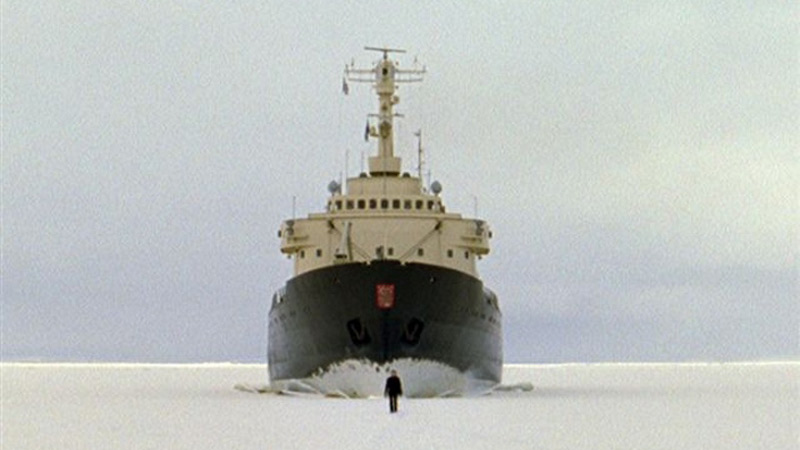
by Guido van der Werve (2007)
16 mm to DVD, color, sound, 10 min loop
 Dutch artist Guido van der Werve makes the kind of films Caspar David Friedrich might have dreamt up if he had had a sense of humour and access to a camera. It is impossible, when witnessing such overwrought, touching and often hilarious scenes, not to think of Van der Werve as the love child of Bas Jan Ader, another Dutch artist preoccupied with the slapstick possibilities of isolation, sadness, alienation and the elements, especially water (into which, of course, Ader eventually and tragically disappeared).
Dutch artist Guido van der Werve makes the kind of films Caspar David Friedrich might have dreamt up if he had had a sense of humour and access to a camera. It is impossible, when witnessing such overwrought, touching and often hilarious scenes, not to think of Van der Werve as the love child of Bas Jan Ader, another Dutch artist preoccupied with the slapstick possibilities of isolation, sadness, alienation and the elements, especially water (into which, of course, Ader eventually and tragically disappeared).When "Nummer Acht" opens, everything is not all right. After a few seconds of a soundless, white-titles-on-black background screen, a blinding whiteness and massive roar shock us into high alert. The opening image will carry us through the film's full 10 minutes: We see a lone, black-clad man walking toward us on a seemingly endless ice sheet. He is trailed -- methodically, menacingly -- by a massive icebreaker, a behemoth of a ship lumbering through expanses of seemingly immovable ice. We are in the Gulf of Bothnia, the northernmost expanse of the Baltic Sea near a Finnish port town. Van der Werve took a small crew there to film his 2007 pas de deux with the icebreaker Sampo. The ship towers over van der Werve's minuscule figure. It's a beast of a machine, confidently biting through the floe as ice crumbles against its powerful hull. The monster is largely faceless: Its black and white prow is many times larger than its above-deck operations tower, and there's no sign of life inside. Both boat and figure move in lockstep. Van der Werve continues forward while the icebreaker keeps pace. The scene appears as if it could go on indefinitely. To suggest just such an endless journey, van der Werve ends the film as suddenly as it began, snapping back to a silent black screen and final credits.
What to make of this? Though the action is minimal, the psychology is intense. The stark image of man pursued by industrial beast glues us to our seats. When will the man fall tragically through the ice? When will he break into a run? Will the ship give up pursuit? As time passes and it becomes clear that, in fact, nothing will happen next, the film turns into a philosophical exercise. The artist's steady progress -- neither a march nor an amble, it's the walk of a distracted window shopper or a tourist determined to blend in -- turns into a metaphor for our journey through life. The beast at his tail stands in for the demons that accompany us from childhood unto death. Though the figure appears unaware of the monster behind him, he never wavers in his forward march, suggesting that he knows better than to stop. As viewers, we feel at first as if we know something that our hero doesn't. His walk appears too relaxed, he must not know what's behind him. Yet as the film progresses, we begin to understand that he probably does know. He just wants to keep moving. As we watch, we begin to understand. The ship becomes a little less menacing. We, like van der Werve, are getting comfortable with our demons.
(Text parts borrowed from Jessica Dawson, washingtonpost.com & Jennifer Higgie, frieze.com)
To see a bootleg, simply follow the link below. Enjoy.
http://www.youtube.com/watch?v=J58WGm0Wibo
Greetings, I like your website. This is a nice site and I wanted to post a comment to let you know, good job! Thanks Lisa
ReplyDeleteLouis Vuitton
louis vuitton
You wouldn¡¯t believe it but I¡¯ve wasted all day digging for some articles about this. You¡¯re a lifesaver, it was an excellent read and has helped me out to no end. Cheers,
ReplyDelete